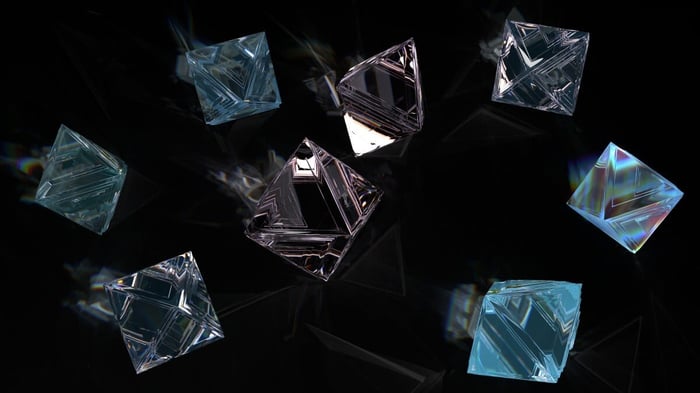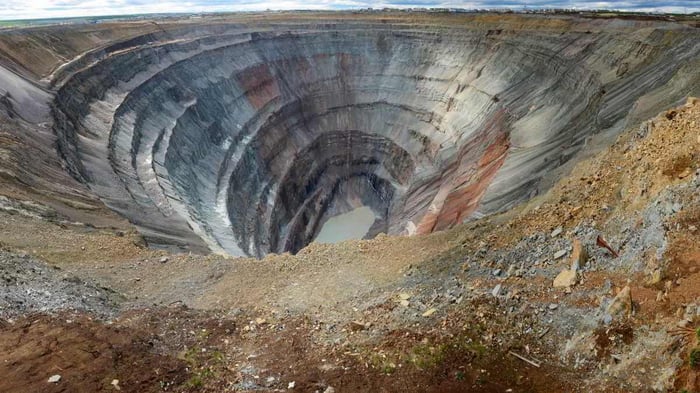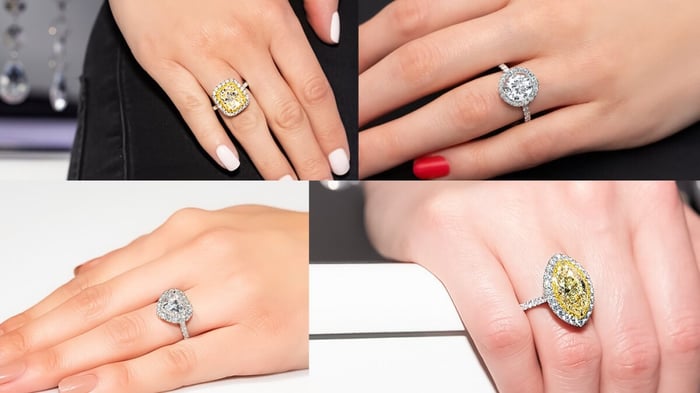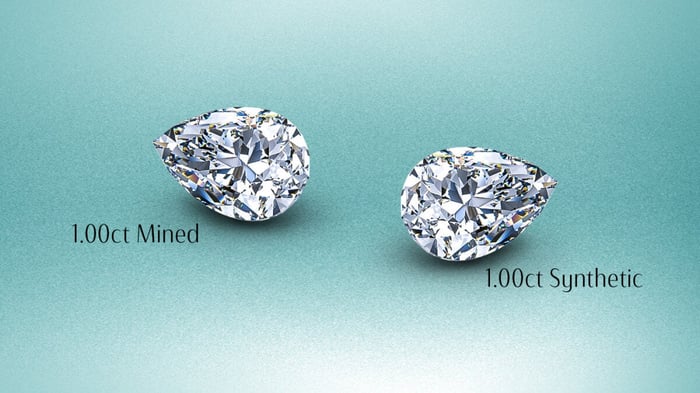Diamond Fluorescence, Is A Fluorescent Diamond Good?
When you go shopping for diamond jewellery you may see jewellery labelled as having diamonds that fluoresce. When it is on the label along with all the other specifications about the diamond quality a fluorescent diamond must be a good thing? Right?
Well, not so fast!
Because the answer to the question is a cautious ‘maybe’ or ‘possibly’.
To find out whether you should buy a diamond that fluoresces, you need to know why a diamond might be fluorescent and what that means to you as the buyer. In this article, we will dive into the subject and give you some guidance.
What Is Diamond Fluorescence?
When a diamond fluoresces, it emits a soft glow under UV (ultraviolet) light. Only about 30% of all diamonds exhibit this effect at all. Usually, the colour is blue, but it can sometimes show as red, green, white or yellow.
The fluorescent effect comes from trace impurities in the diamond. The only elements that fluoresce in diamonds are aluminium, nitrogen, and boron.
Almost all diamonds have some form of impurity picked up within the crystal over the millions of years that went into its formation.
Most of the time, we only notice the effect under strong UV light such as in a nightclub or when being examined by a jeweller. However, given that sunlight and fluorescent lighting also contain UV rays, the effect can be seen even under normal daylight or indoors.
How Is Diamond Fluorescence Graded?
The degree of fluorescence will vary according to the amount of impurity in the diamond crystal. The greater the level of impurity present the more the diamond will emit its glow.
The Gemological Institute of America (GIA) measures and records the level of fluorescence in the diamonds it grades. At All Diamond, all our diamonds that are 0.50 carats or larger will have a GIA certificate of quality so you will see the amount of fluorescence present if it is present at all.
The GIA use the following scale:
None, Faint, Medium, Strong and Very Strong when compared to reference master stones used in the grading lab.
When the fluorescence observed is Medium, Strong, or Very Strong, the colour of the fluorescence will be noted on the grading report. It is worth noting that the GIA does not consider fluorescence to be a quality factor but an identifying characteristic that helps identify a diamond by its unique characteristics.
Classic Diamond Tennis Bracelet 7.00ct G/SI in 18k White Gold
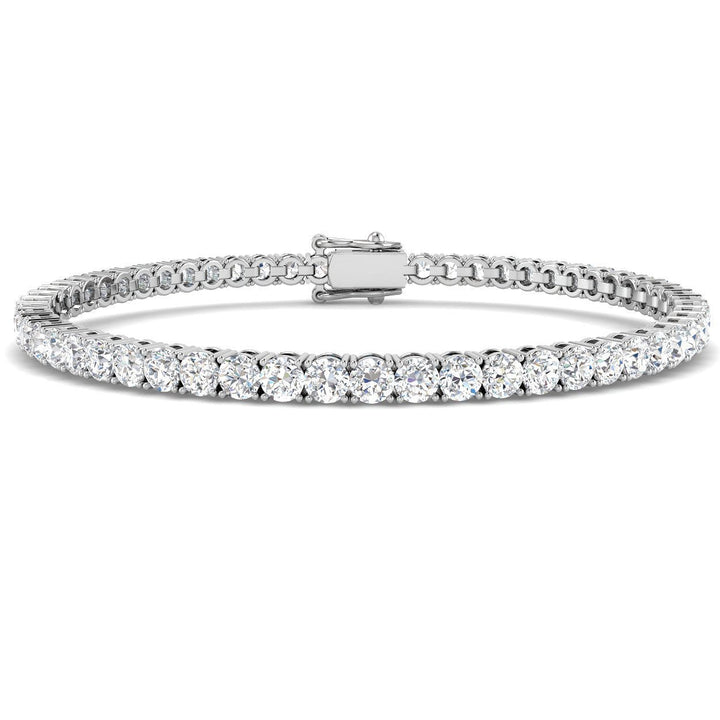
£8,531.00
£16,317.00
Seven carats of gleaming, hand-cut diamonds placed perfectly in lustrous 18k white gold that will flow against the skin and create an incredible glimmering effect to elevate any outfit you pair it with. UK hallmarked and with a lifetime guarantee… read more
What Is The Effect Of Fluorescence?
The most noticeable effect of fluorescence in diamonds is a blue glow which may be very faint but can be quite strong.
The blue glow can make diamonds that are slightly yellow, in colour grades I to M appear whiter under a UV light source. Many people think this makes these lower colour grade diamonds look better. For this reason, jewellers selling fluorescent diamonds of lower colour grades often sell them at a higher price than non-fluorescing diamonds.
However, the same is not the case for higher colour graded diamonds. D – H graded diamonds that fluoresce can have their appearance degraded. Such diamonds can have a milky or oily appearance, particularly if the fluorescence is strong. This oily or milky appearance is not present in all fluorescent diamonds. However, in higher quality diamonds, the price is often slightly lower when fluorescence is recorded.
In the case of fancy coloured diamonds, fluorescence is often regarded as a benefit no matter how strong the effect. The glow under UV light tends to make the diamond’s colour stronger. This is not all positive though, in strongly fluorescent yellow diamonds, the effect can make the yellow colour look brown or milky, neither of which are good!
Will You Ever Notice Diamond Fluorescence?
This is not a question with a clear-cut answer!
According to the GIA, most people are unable to tell if a diamond has fluorescence under normal conditions. However, under UV lighting in nightclubs and similar environments, one may be able to see the effect, particularly if the room otherwise dark. Many jewellers disagree with the GIA on the subject and, to a degree that makes sense, especially when comparing two diamonds side by side. Personally, I would not want to buy jewellery with two or more large diamonds where one or two had fluorescence and the other did not.
Diamond Halo Earrings 0.75ct G/SI Quality in 18k Rose Gold

£1,779.00
£3,127.00
This handmade pair of beautiful halo earrings in warm 18k rose gold will make a treasured gift for your special someone. You can be sure that these lovely diamond earrings will be a part of her jewellery collection that she… read more
So, Should You Buy Jewellery With Fluorescent Diamonds?
Given that fluorescent diamonds tend to sell for less than ones that do not, as long as you are happy with the appearance of the diamond then a fluorescent diamond can enable you to save some money. And, in the case of lower grade diamonds, it may make the diamond look a little better.
On the other hand, never pay extra for a diamond that has fluorescence. In the case of jewellers charging more money for low-grade diamonds that glow – just buy a better-quality diamond in the first place.
Most of the time, jewellers do not indicate the presence or absence of fluorescence, it makes little to no difference to most buyers in most diamonds.
The Online Diamond Jewellery Buying Advantage
At All Diamond, we offer at least 30 days after receipt of your new jewellery purchase for exchanges and returns. Many other online jewellers offer similar. Most high-street sellers do nothing like this. This online return opportunity gives buyers of fluorescent diamonds a big advantage. If you see a fluorescent diamond being sold at a good price, you can order it, examine it in your home, in daylight, even take it to a nightclub. If you are unhappy with the way it looks, just send the item back and get another piece of jewellery!
At All Diamond, we do not identify the fluorescence of a diamond. It will always be noted on the GIA grading certificate if it is present. For the grades of diamonds we sell, it is not an issue. We do not sell low colour graded diamonds. The reality is, as the GIA suggests, most people simply cannot tell the difference in any normal situation!
Please take a moment to browse our ranges of UK designed and handcrafted diamond jewellery. We offer high-quality jewellery to suit most budgets. Our jewellery always carried a lifetime workmanship guarantee, carries a 30-day return or exchange period and is despatched by a secure, insured carrier.
Certified Round Diamond Engagement & Wedding Ring 0.90ct G/SI 18k White Gold

£1,650.00
£2,907.00
We know you want everything about your special day to be perfect. Ensure matching rings are one thing less to worry about with this beautiful bridal set in brilliant 18k white gold with the sparkle of 0.90 carats of hand-cut,… read more
We look forward to helping you with your next jewellery purchases.
